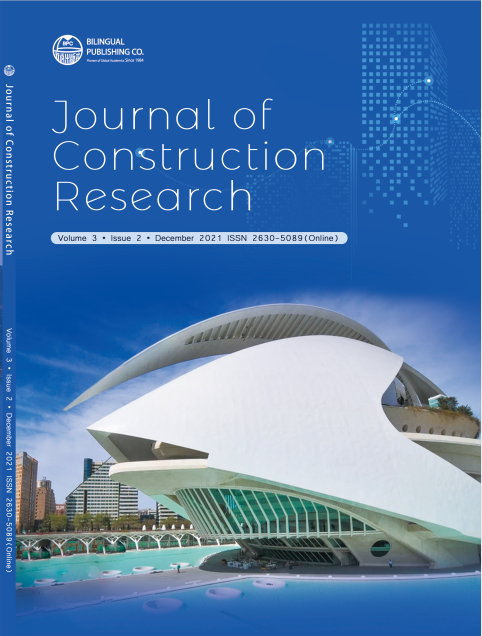Evaluation of Thermal Comfort in The Design of Student Hostel at Federal University of Technology Minna, Nigeria
DOI:
https://doi.org/10.30564/jcr.v3i2.4137Abstract
Buildings are designed to offer protection to the occupants against harshoutdoor environment thereby enhancing optimal indoor comfort. Overthe years, there have been a rise in population of students applying foradmission into tertiary institution, which has led to an increase in thenumber of students that resides at the university hostel. These rise in thenumber of students, has brought about overcrowding and stretching offacilities, with spaces which were originally intended for four students arenow been habited by six to eight students thereby causing imbalance inthe general indoor climatic condition. The study is aimed at investigatingthermal comfort in student’s accommodation in tertiary institutionstowards achieving a better thermal condition in the hostel environment.The objective is to evaluate the thermal performance in the student hostelaccommodation, and also to identify passive ways of controlling thermalperformance in student dwelling buildings at Federal University ofTechnology Minna main campus, Gidan Kwano. For the purpose of thisresearch work, primary data were collected through the use questionnaire,case studies and observation. Secondary data were collected from availableliterature, internet, and studying of similar existing facilities. The studyrevealed that most student hostel possessed few elements of passive coolingtechnique which in turn deprives students a quality conducive environment.The research recommends that soft landscaping elements should be adoptedand deciduous trees planted in the environment for cooling effect duringhot and humid period, provision of two openings in each room if possible.This can be achieved through proper building orientation, use of highthermal mass to reduce heat absorption, use of high thermal mass withnight cooling, roof, ceiling and attic insulation. Designing in a hot climatearea requires lots of consideration, which is mentioned above so as toincorporate a general conducive indoor thermal comfort for the users.Keywords:
Building Orientation, Passive Cooling, Thermal comfort, Thermal performanceReferences
[1] Akande, O.K., Olagunju, R.E., Aremu, S.C. & Ogundepo, E.A., 2018. Exploring Factors Influencing of Project Management Success in Public Projects in Nigeria. Academic Journals.
[2] DOI: https://doi.org/10.2478/jbe-2018-0004.
[3] Aluko, M., 2009. Climate Considerations in Building and Urban Design.
[4] AMCORD, 1995. Australian Model Code for Residential Development. Published by Australian press.
[5] Banji, O.K., 2006. Institutional Support for Collective Learning: Cluster Development in Kenya and Ghana. volume 12; 258-278.
[6] Bansal, H.G., 2007. Passive Building Design: A handbook of Natural Climatic Control Construction in Developing Countries.
[7] Esenwa, O.G., 2003. Proposal on Private Sector Participation in University Hostel Development and Management in Nigeria.
[8] Henry, J.S., 2005. Dictionary of Architecture and Building Technology. Published in the Taylor and Francis e-library.
[9] Hossain, 2013. Pupil Personnel Management in School. A new emphasis under the UBE Scheme, Ahmadu Bello University Press. Journal of Education, Legal and Management Studies.
[10] Iyizoba, O., 2009. Public Private Partnership Concept as a Means of Providing Hostels Accommodation in Tertiary Institutions.
[11] Joachim, O.A., 2010. An Assessment of the Management of Students’ Hostel in Tertiary Institutions in Owerri, Imo state.
[12] Ogunsote, O.O., 1993. An Introduction to Building Climatology – a basic course for Architecture students, Ahmadu Bello University Press.
[13] Ogunsote, O.O., 2002. Control of Tropical Microclimate through Landscape Design; Concept and Method. A Journal of Landscape Design for the Federal Capital Development Authority, Ahmadu Bello University Press.
[14] Oluigbo, S.N., 2010. Context and Application of Case Studies in Architectural Research.
Downloads
Issue
Article Type
License
Copyright and Licensing
The authors shall retain the copyright of their work but allow the Publisher to publish, copy, distribute, and convey the work.
Journal of Construction Research publishes accepted manuscripts under Creative Commons Attribution-NonCommercial 4.0 International License (CC BY-NC 4.0). Authors who submit their papers for publication by Journal of Construction Research agree to have the CC BY-NC 4.0 license applied to their work, and that anyone is allowed to reuse the article or part of it free of charge for non-commercial use. As long as you follow the license terms and original source is properly cited, anyone may copy, redistribute the material in any medium or format, remix, transform, and build upon the material.
License Policy for Reuse of Third-Party Materials
If a manuscript submitted to the journal contains the materials which are held in copyright by a third-party, authors are responsible for obtaining permissions from the copyright holder to reuse or republish any previously published figures, illustrations, charts, tables, photographs, and text excerpts, etc. When submitting a manuscript, official written proof of permission must be provided and clearly stated in the cover letter.
The editorial office of the journal has the right to reject/retract articles that reuse third-party materials without permission.
Journal Policies on Data Sharing
We encourage authors to share articles published in our journal to other data platforms, but only if it is noted that it has been published in this journal.




 Akande O.K.
Akande O.K.

